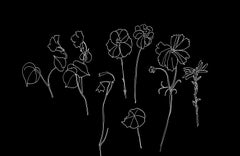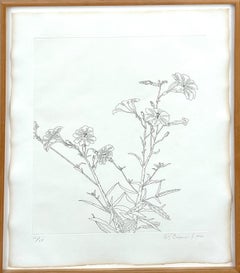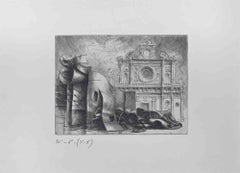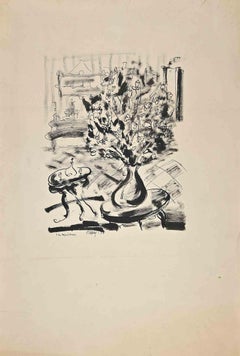Drawing Still-life Prints
to
74
212
78
70
11
14
Overall Width
to
Overall Height
to
101
91
68
14
8
8
6
3
3
3
2
1
28
12
8
7
7
12
15
290
68
1
3
3
23
26
55
82
48
10
5
269
101
14
861
780
702
495
426
385
272
271
236
194
192
187
156
153
139
136
131
130
113
105
136
129
54
40
27
24
119
212
151
Art Subject: Drawing
White Line Flowers VIII
Located in Dallas, TX
This is a unique work.
The image size is 12 x 18 1/2 inches, and the paper size is 17 x 25 inches.
The price does not include a frame.
Gail Norfleet earned her BFA at The Universi...
Category
2010s Contemporary Still-life Prints
Materials
Archival Pigment
Zen Minimalist Flowers Etching American Modernist Ed Baynard Pop Art Print
By Ed Baynard
Located in Surfside, FL
ED BAYNARD (American, 1940-2016)
Flowers, Flowers in a Vase, Etching.
1979/1980,
Hand signed, dated l.r.,
Hand numbered from small edition 12/24,
Dimensions: 23 by 19 in. Framed 25 by 21 in
Born in Washington, D.C. in 1940. Raised in Washington, D.C. and newly graduated from high school, he flew to Europe living off and on in Paris and London. During this time, he designed costumes for Jimi Hendrix, worked as a graphic designer for the Beatles as well as Elizabeth Taylor and Richard Burton. Returning to New York, he dedicated his life to art after a surprise success with his first show in 1971 at the Willard Gallery in NYC. Ed's images are Zen-like in their simplicity and grace rendered in a flat, graphic style that recalls Japanese Ukiyo-e prints. His watercolors are luminous, like the rest of his representations regardless of the medium. The Japanese inspired ukiyo-e style woodblock prints and lithograph works he created at Tyler Graphics in 1980 contain a 20th century "floating world" sensibility. Ed's wish was to bring harmony, color, and a meditative stillness to this chaotic planet. He did so in a gentle and powerful way, always as an expression of his deep gratitude for the love and beauty, friendship, and concerns he held dearest. His first solo exhibition was in 1971 at New York's legendary Willard Gallery on the recommendation of Agnes Martin. Baynard went on to have exhibitions at galleries including Betty Parsons Gallery, New York (1973); Marian Goodman Gallery, New York (1977); John Berggruen Gallery, San Francisco (1980); and Barbara Gladstone Gallery, New York (1980/81).. Baynard manages to retain a simplicity of form inspired by a love of Japanese Woodblock prints. His new works reflect the same poetry of his earlier paintings, retaining his stylized compositions with their Zen like minimalism and Oriental calm, along with a new sense of rhythm and movement. Baynard uses familiar themes such as flowers, plants, pots, and vases, incorporating them into his delicate watercolor still lifes, thus creating stunning visual feasts. He was included in the 1972 Landscape exhibition at MoMA NY alone with other luminaries James Boynton...
Category
1980s American Modern Still-life Prints
Materials
Etching
D is for Dish (A fine whimsical work by a pioneer in the English Pop Art scene)
Located in New Orleans, LA
British Pop artist Harvey Daniels created this image in 1970 in a small edition of 20. This impression is #2 His work has described by art historian Norbert Lynton as a “visual carni...
Category
1970s Pop Art Still-life Prints
Materials
Lithograph
Hiboux et Chouettes #7, portrait of an owl by Marjan Seyedin
Located in Palm Springs, CA
Medium: aquatint and drypoint
Year: 2016
Edition of 21
Image Size: 16 × 12 inches
portrait of a seemingly disgruntled owl in a nocturnal setting, by Franco-Iranian artist Marjan S...
Category
2010s Contemporary Still-life Prints
Materials
Drypoint, Aquatint
Cathedral - Etching by Riccardo Tommasi Ferroni - 1970s
Located in Roma, IT
Cathedral is an etching realized by the Italian artist Riccardo Tommasi Ferroni (1934-2000).
The state of preservation is good.
Tommasi Ferroni's style is recognizable in the flu...
Category
1970s Modern Figurative Prints
Materials
Etching
Flowers - Original Ink Drawing by Robert Naly - Mid 20th Century
By Robert Naly
Located in Roma, IT
Flowers is an original Contemporary artwork realized in the half of the 20th Century by Robert Naly (1900 - 1983).
Original ink drawing.
Hand-signed.
Good conditions except for ...
Category
Mid-20th Century Modern Figurative Prints
Materials
Ink
Salvador Dali - The Negresses - Original Stamp-Signed Etching
Located in Collonge Bellerive, Geneve, CH
Salvador Dali - Original Etching
Stamp signed by Dali
Edition of 294 copies.
Paper : Arches vellum.
Dimensions : 16x12".
Catalogue Raisonné : Field 68-6 (p. 40-41).
Category
1960s Surrealist Figurative Prints
Materials
Etching
"Simple Delight" - Wine Glass & Rose Still Life Etching in Ink on Paper (#6/15)
Located in Soquel, CA
Art nouveau style illustration by Curtis G. Leonardo (American, b. 1960). A rose with a few leaves sits in a wineglass, with a pencil at the base. The composition is slightly abstracted, with geometric shapes creating a backdrop for the still life. This piece has an art nouveau style, with heavy transparent outlines to the objects.
Numbered, titled, signed, and dated along the bottom edge: 6/15 Simple Delight Curtis G. Leonardo '81
Presented in a new grey mat with foamcore backing.
Mat size: 16"H x 12"W
Paper size: 15"H x 11"W
Curtis G. Leonardo (American, b. 1960) grew up in San Leandro...
Category
1980s Art Nouveau Still-life Prints
Materials
Paper, Ink, Etching
Léger, Composition, Mon ami Léger (after)
Located in Southampton, NY
Lithograph and stencil on vélin d'Arches paper. Inscription: Unsigned and unnumbered, as issued. Good condition. Notes: From the album, Mon ami Léger par André Maurois de l'Académie ...
Category
1950s Modern Still-life Prints
Materials
Lithograph, Stencil
$1,036 Sale Price
20% Off
Op. 301 Three Marrons
Located in Palm Springs, CA
Three Marrons, Diamond drypoint by Jakob Demus.
In the 1986-1988 period Demus immersed himself in the depiction of flowers, and it was then that the most important works in this ge...
Category
Early 2000s Contemporary Still-life Prints
Materials
Drypoint
Léger, Composition, Mon ami Léger (after)
Located in Southampton, NY
Lithograph and stencil on vélin d'Arches paper. Inscription: Unsigned and unnumbered, as issued. Good condition. Notes: From the album, Mon ami Léger par André Maurois de l'Académie ...
Category
1950s Modern Still-life Prints
Materials
Lithograph, Stencil
$1,036 Sale Price
20% Off
Seated Nude - Original handsigned lithograph
Located in Paris, IDF
Jean-Baptiste VALADIE
Seated Nude
Original lithograph
Handsigned in pencil
Justified EA (artist proof)
On vellum 51 x 39 cm (c. 20 x 16 in)
Very good condition, light defects at th...
Category
Late 20th Century Modern Still-life Prints
Materials
Lithograph
Frontispiece from the Rilke Portfolio, Minimalist lithograph by Ben Shahn
By Ben Shahn
Located in Long Island City, NY
Artist: Ben Shahn, American (1898 - 1969)
Title: Frontispiece (Portrait) from the Rilke Portfolio
Year: 1968
Medium: Lithograph on Arches, signed in the plate
Edition: 750
Size: 22.5...
Category
1960s Modern Figurative Prints
Materials
Lithograph
poppy
By Jean Bardon
Located in Palm Springs, CA
The formality, ornamental qualities and boldness of botanical art strongly influence Bardon's art. It is easy to see her inspiration in the patterns, line and simplicity of form foun...
Category
21st Century and Contemporary Contemporary Still-life Prints
Materials
Etching, Aquatint
Black Ballet
By Kim Frohsin
Located in Burlingame, CA
Monotype ev edition 1/3 with hand coloring. The plate (image of ballet slippers) is 15 x 14 inches and the overall paper size is 23 1/2 x 22 inches. Kim Frohsin spent 12 years workin...
Category
21st Century and Contemporary Contemporary Still-life Prints
Materials
Monotype
Delvaux, Confidences, Souvenirs et portraits d'artistes (after)
By Paul Delvaux
Located in Southampton, NY
Lithograph on vélin d'Arches paper. Unsigned and unnumbered, as issued. Good condition. Notes: From the folio, Souvenirs et portraits d'artistes, 1972. Published by Fernand Mourlot, ...
Category
1970s Modern Landscape Prints
Materials
Lithograph
$796 Sale Price
38% Off
Recollections
Located in Palm Springs, CA
Signed and numbered from the edition of 10.
Yuji Hiratsuka was born 1954 in Osaka, Japan. In 1985 he moved to the United States to pursue graduate degrees in printmaking at New Mexi...
Category
2010s Contemporary Portrait Prints
Materials
Intaglio
Flowering Lily Plants: A 17th C. Besler Hand-colored Botanical Engraving
Located in Alamo, CA
This is a hand-colored copper plate engraving entitled "Cataputia Vulgaris, Parietaria Sylvestris, Nummularia", depicting flowering Spanish Nut, Yellow Turk's-cap Lily, Yellow Turk's...
Category
1640s Academic Still-life Prints
Materials
Engraving
Weightlifter - Aquatint and Etching by Fifo Stricker - 1981
Located in Roma, IT
Weightlifter is a contemporary artwork realized by the artist Fifo Stricker in 1981.
Mixed colored aquatint and etching. Original title: Gewichtheber
Category
1980s Contemporary Still-life Prints
Materials
Aquatint, Etching
Braque, Composition, Braque Espaces, 13 Dessins, Lavis, Aquarelles (after)
Located in Southampton, NY
Lithograph and stencil on vélin papier a la cuve du moulin richard de bas specialement filigrané pour cette édition paper. Inscription: signed in the plate and unnumbered, as issued....
Category
1950s Modern Landscape Prints
Materials
Lithograph, Stencil
$3,996 Sale Price
20% Off
Braque, Composition, Braque Espaces, 13 Dessins, Lavis, Aquarelles (after)
Located in Southampton, NY
Lithograph and stencil on vélin papier a la cuve du moulin richard de bas specialement filigrané pour cette édition paper. Inscription: signed in the plate and unnumbered, as issued....
Category
1950s Modern Landscape Prints
Materials
Lithograph, Stencil
$3,996 Sale Price
20% Off
Flowers I Michele Zalopany, black white large abstract floral still life flowers
Located in New York, NY
Large scale black and white stunning abstracted floral still life with sweeping brushstrokes and draped cloth. Lush and painterly composition for minimalist, contemporary and modern ...
Category
1980s Contemporary Figurative Prints
Materials
Monotype
Still Life - Original Woodcut by G. Haas-Triverio - The Early 20th Century
Located in Roma, IT
Still Life is an original woodcut print realized by Giuseppe Haas-Triverio in the early 20th century.
Good conditions.
The artwork is depicted through strong strokes in a well-bala...
Category
Early 20th Century Modern Figurative Prints
Materials
Woodcut
The Harbor Cafe - Original Etching, Handsigned
Located in Paris, IDF
Jean Émile LABOUREUR
The Harbor Cafe, 1921
Original etching
Signed in pencil by the artist
Numbered on / 50 copies
On vellum 32.5 x 39.5 cm (c. ...
Category
1920s Analytic Cubist Still-life Prints
Materials
Etching
Giacometti, Fleurs, Souvenirs et portraits d'artistes (after)
Located in Southampton, NY
Lithograph on vélin d'Arches paper. Unsigned and unnumbered, as issued. Good condition. Notes: From the folio, Souvenirs et portraits d'artistes, 1972. Published by Fernand Mourlot, ...
Category
1970s Modern Landscape Prints
Materials
Lithograph
$716 Sale Price
55% Off
Elizabeth's Cone
Located in Burlingame, CA
'Elizabeth's Cone', Aquatint Etching with the plate (image itself) 15 x 22 inches. On a larger sheet of archival paper. An iconic still life image featuring the “tragedy” of a drop...
Category
21st Century and Contemporary American Realist Still-life Prints
Materials
Etching, Aquatint
"S (It Is Safe To Be A Woman)", silkscreen print, double-sided, cotton rag paper
Located in Toronto, Ontario
"S (It Is Safe To Be A Woman)", 2018, is a limited-edition silkscreen print, double-sided by Andrew Cornell Robinson. This print is an edition of 40. Each print is signed, stamped and numbered. The prints measure 17x17".
Note the double-sided printing – surfaces of text, surfaces of image. See the full installation (photo above) as a striking performance in itself with myriad possibilities for color, pattern, language, culture, politics, identity. It's a dynamic body of work that delights in the craft of making and the experience of revealing a tapestry of image and language.
Initially inspired by a visit to the Talking Sculptures...
Category
21st Century and Contemporary Contemporary Figurative Prints
Materials
Paper, Archival Paper, Color, Screen
M's Orchard, by David Smith-Harrison
Located in Palm Springs, CA
Signed, titled and numbered by the artist. This intaglio print shows an orchard combined with the classical architectural imagery that often accompany Smith-Harrison's portraits of ...
Category
Early 2000s Contemporary Landscape Prints
Materials
Etching, Aquatint
Europa, by Peter Milton
By Peter Milton
Located in Palm Springs, CA
Resist Ground Etching and Engraving from a Copper Plate on BFK Rives, Somerset Buff, Wove Paper
Medium: Resist Ground Etching & Engraving
Edition of 125
Year: 1982
One o...
Category
1980s Contemporary Interior Prints
Materials
Engraving, Etching
Still Life - Etching by Leo Guida - 1976
By Leo Guida
Located in Roma, IT
Still Life is an artwork realized in 1976 by the Italian Contemporary artist Leo Guida (1992 - 2017).
Original screen print on cardboard
Hand-signed on the lower right in pencil ...
Category
1970s Contemporary Figurative Prints
Materials
Etching
Souliers No 2
By Kim Frohsin
Located in Burlingame, CA
Monotype EV edition variée 1/4, with heavy hand coloring: mixed media, featuring satin wedding shoes. Signed front in pencil by Kim Frohsin, who is strongly associated with the Bay ...
Category
21st Century and Contemporary Contemporary Still-life Prints
Materials
Monotype
Still Life - Screen Print by Leo Guida - 1976
By Leo Guida
Located in Roma, IT
Still Life is an artwork realized in 1976 by the Italian Contemporary artist Leo Guida (1992 - 2017).
Original screen print on cardboard
Hand-signed on the lower right in pencil ...
Category
1970s Contemporary Still-life Prints
Materials
Screen
Wild Flowers I, Modern Etching by Aubrey Schwartz
Located in Long Island City, NY
Aubrey Schwartz, American (1928 - 2019) - Wild Flowers I, Year: 1966, Medium: Etching, signed and numbered in pencil, Edition: 28/100, Image Size: 4.75 x 3.75 inches, Size: 14 x 10...
Category
1960s Modern Still-life Prints
Materials
Etching
Weightlifter - Aquatint and Etching by Fifo Stricker - 1981
Located in Roma, IT
Weightlifter is a contemporary artwork realized by the artist Fifo Stricker in 1981.
Mixed colored aquatint and etching. Original title: Gewichtheber
Category
1980s Contemporary Still-life Prints
Materials
Aquatint, Etching
4 cores - XXI Century, Contemporary Etching Print, Figurative, Still life
Located in Warsaw, PL
ZDZISŁAW WIATR (born 1960)
He graduated from the Academy of Fine Arts in Cracow, at the Faculty of Graphic Arts in Katowice, where in 1986 he received a diploma with the honourable m...
Category
21st Century and Contemporary Contemporary Still-life Prints
Materials
Paper, Etching
Chagall, Bouquet pour Fernand, Souvenirs et portraits d'artistes (after)
By Marc Chagall
Located in Southampton, NY
Lithograph on vélin d'Arches paper. Unsigned and unnumbered, as issued. Good condition. Notes: From the folio, Souvenirs et portraits d'artistes, 1972. Published by Fernand Mourlot, ...
Category
1970s Modern Landscape Prints
Materials
Lithograph
$1,036 Sale Price
35% Off
COMPOSITION RED Signed Lithograph, Abstract Floral Still Life, Round Blue Vase
By Peter Max
Located in Union City, NJ
COMPOSITION RED is an original hand drawn lithograph by the renowned American Pop artist, Peter Max, printed using traditional hand lithography techniques on archival printmaking pap...
Category
1980s Pop Art Still-life Prints
Materials
Lithograph
Oiseaux #1, from a series on birds by Marjan Seyedin
Located in Palm Springs, CA
Medium: Aquatint and drypoint
Year: 2011
Edition of 21
Image Size: 7 × 3.54 inches
Portrait of a bird from a series by Franco-Iranian artist Marjan Seyedin. In her works, the an...
Category
2010s Contemporary Still-life Prints
Materials
Drypoint, Aquatint
Portrait of Boy - Original Drawing by Hugo Pereyra - 1964
Located in Roma, IT
Portrait of Boy is an original artwork realized by Hugo Pereyra in 1964.
Original Ink and Watercolor
Hand-signed.
Category
1960s Modern Figurative Prints
Materials
Watercolor, Ink
Fishbone - Original Etching by Massimo Baistrocchi - 1972
Located in Roma, IT
"Fishbone" is a beautiful print in etching technique, realized by Massimo Baistrocchi in 1972.
Hand-signed and dated, on the lower right in pencil, Numbered, edition of 19/50 prints...
Category
1970s Modern Figurative Prints
Materials
Etching
1998 Signed Limited Edition Lithograph Le Pont Alexandre III
Located in Rochester Hills, MI
Artist: Isabelle Planté
Title: Le Pont Alexandre III - 1998
Print - Lithograph on Arches Archival Paper
Size: 19'' x 25.5''
Edition: Signed in pencil and marked 24/90
image size ...
Category
1990s Surrealist Still-life Prints
Materials
Lithograph
Weightlifter - Aquatint and Etching by Fifo Stricker - 1981
Located in Roma, IT
Weightlifter is a contemporary artwork realized by the artist Fifo Stricker in 1981.
Mixed colored aquatint and etching. Original title: Gewichtheber
Category
1980s Contemporary Still-life Prints
Materials
Aquatint, Etching
Topiaire Habite
Located in Palm Springs, CA
Signed, titled and numbered from the edition of 30. Imaginary topiary and garden scene, with incredibly fine line work in one of Houtin's earliest etchings.
François Houtin was born in Craon en Mayenne, France in 1950. He has lived and worked in Paris since 1971. He was trained as a landscape architect, and worked on such prominent projects as the renovation of the Jardin des Tuilleries in 1991. It wasn't until 1973 that he learned printmaking from Jean Delpech, and by 1979 he had become a full-time artist known for his highly detailed prints...
Category
1970s Contemporary Landscape Prints
Materials
Etching
Everything that is living is part of us
By Amy Wilson
Located in Red Bank, NJ
Everything that is living is part of us by Amy Wilson
Print, Textile Art, Black and White, Doodles, Drawing, Figures, Home Decor, Wall Art, Patterns
Category
20th Century Contemporary Still-life Prints
Materials
Linocut
Norman Barr, Still Life
By Norman Barr
Located in New York, NY
Norman Barr made mural on the NYC-WPA; this lithograph was made in the WPA workshop but was not published by the WPA. The next year he was in the Army! Thi...
Category
Mid-20th Century Ashcan School Interior Prints
Materials
Lithograph
Flowers - Original Etching on Paper - 1970s
Located in Roma, IT
Flowers is a beautiful original etching by the Italian artist Paulucci.
Signed on the lower right margin.
Edition, 43/75
The artwork represents flowers, depicted by strong express...
Category
1970s Contemporary Figurative Prints
Materials
Etching
Il Giacinto - Original Etching by Luigi Bartolini - 1935
Located in Roma, IT
Image dimensions: 16.7 x 10.7 cm.
This is an original etching realized by Luigi Bartolini in 1934. Hand signed in pencil on the lower right and titled on the lower left.
Very good ...
Category
1930s Figurative Prints
Materials
Etching
After Pablo Picasso - Cubism - Pochoir
Located in Collonge Bellerive, Geneve, CH
After Pablo Picasso - Cubism - Pochoir
Dimensions: 48.5 x 36 cm
1962
Edition of 260
Daniel Jacomet, LEDA, Editions d'Art
Pablo Picasso
Picasso is not just a man and his work. Picas...
Category
1960s Modern Figurative Prints
Materials
Lithograph
Salvador Dali - Woman with the Crutch - Original Stamp-Signed Etching
Located in Collonge Bellerive, Geneve, CH
Salvador Dali - Woman with the Crutch - Original Stamp-Signed Etching
Stamp signed by Dali
Edition of 294 copies.
Paper : Arches vellum.
Dimensions : 16x12".
Catalogue Raisonné : ...
Category
1960s Surrealist Figurative Prints
Materials
Etching
Composition n. 20 - Etching by Vairo Mongatti - 1970s
Located in Roma, IT
Composition n. 20 is an original artwork realized in the 1970s by Vairo Mongatti.
Black and white etching.
Hand signed and numbered. Edition of 26/120 prints.
Category
1970s Contemporary Still-life Prints
Materials
Etching
Charlie Davies, Flying Amongst the Flowers, Limited Edition Print, Floral Art
Located in Deddington, GB
Charlie Davies
Flying amongst the flowers
Original botanical etching
Soft ground etching on paper
Image Size: 35 cm x 35 cm x 1 cm
Sheet/Canvas Size: 50 cm x 50 cm x 1 cm
Unframed
Fr...
Category
21st Century and Contemporary Impressionist Still-life Prints
Materials
Paper, Etching
Wine and Grapes - Original Etching by Maxime Juan - 1955
By Maxime Juan
Located in Roma, IT
Wine and Grapes is an original print in Etching technique on ivory-colored paper, realized by Maxime Juan in 1955.
Hand-signed and dated on the lower right.
Numbered. Edition, 4/20...
Category
1950s Contemporary Still-life Prints
Materials
Paper, Etching
Height of Summer, by Gunnar Norrman
By Gunnar Norrman
Located in Palm Springs, CA
Medium: Drypoint
Image Size: 8.5 x 6.5 inches
Edition 15
Year: 1990
John Russell wrote in a review in the New York Times that "several of Norrman’s images could hang with drawings b...
Category
1980s Contemporary Still-life Prints
Materials
Drypoint
$880 Sale Price
20% Off
Braque, Composition, Verve: Revue Artistique et Littéraire (after)
Located in Southampton, NY
Lithograph on vélin du Marais paper. Inscription: Unsigned and unnumbered, as issued. Good condition. Notes: From the volume, The Intimate Sketchbooks of G. Braque, Verve: Revue Arti...
Category
1950s Modern Landscape Prints
Materials
Lithograph
$716 Sale Price
40% Off
Margaritas
Located in New York, NY
“Margaritas” is a lithograph created by Emilio Sanchez in 1997. This impression is signed, titled, and inscribed "12/50" - the 12 print from an edition of 50 impressions. The printed image size is 12.50 x 14.25 inches (31.3 x 35.7 cm) and the paper size is 18 x 20.13 inches - all four paper edges are decked adding a nice option when framed. This print came to us directly from the Emilio Sanchez Estate (circular estate stamp is on verso). Stamped on verso "Estate of Emilio Sanchez."
“Best known for his architectural paintings and lithographs, Emilio Sanchez (1921-1999) explored the effects of light and shadow to emphasize the abstract geometry of his subjects. His artwork encompasses his Cuban heritage...
Category
Late 20th Century Contemporary Still-life Prints
Materials
Lithograph
Flowers - Original Etching by Walter Piacesi - 1972
Located in Roma, IT
Flowers is an original Contemporary Artwork realized in 1972 by Aldo Castano.
Original B/W Etching on paper.
Hand-signed and dated on the lower right.
Numbered. Edition, XXIV/XXV...
Category
1970s Modern Figurative Prints
Materials
Etching
Flowers - Original Etching on Paper - 1950s
Located in Roma, IT
Flowers is a beautiful original etching by the Italian artist Paulucci.
Signed on the lower right margin.
Artist's proof
The artwork represents flowers, depicted by strong express...
Category
1950s Contemporary Figurative Prints
Materials
Etching
Wild Flowers III, Modern Etching by Aubrey Schwartz
Located in Long Island City, NY
Aubrey Schwartz, American (1928 - 2019) - Wild Flowers III, Year: 1966, Medium: Etching, signed and numbered in pencil, Edition: 28/100, Image Size: 4.75 x 3.75 inches, Size: 14 x 1...
Category
1960s Modern Still-life Prints
Materials
Etching
Still Life on a Chair - Original Etching by Marco Bellagamba - 1969
Located in Roma, IT
Still Life on a Chair is an original artwork realized by Marco Bellagamba in 1969.
Black and white etching, image dimensions 32 x 34 cm.
Hand-signed and dated by the artist on the ...
Category
1960s Modern Figurative Prints
Materials
Etching
Still Life - Etching by Leo Guida - 1976
By Leo Guida
Located in Roma, IT
Still Life is an artwork realized in 1976 by the Italian Contemporary artist Leo Guida (1992 - 2017).
Original screen print on cardboard
Hand-signed on the lower right in pencil ...
Category
1970s Contemporary Figurative Prints
Materials
Etching





